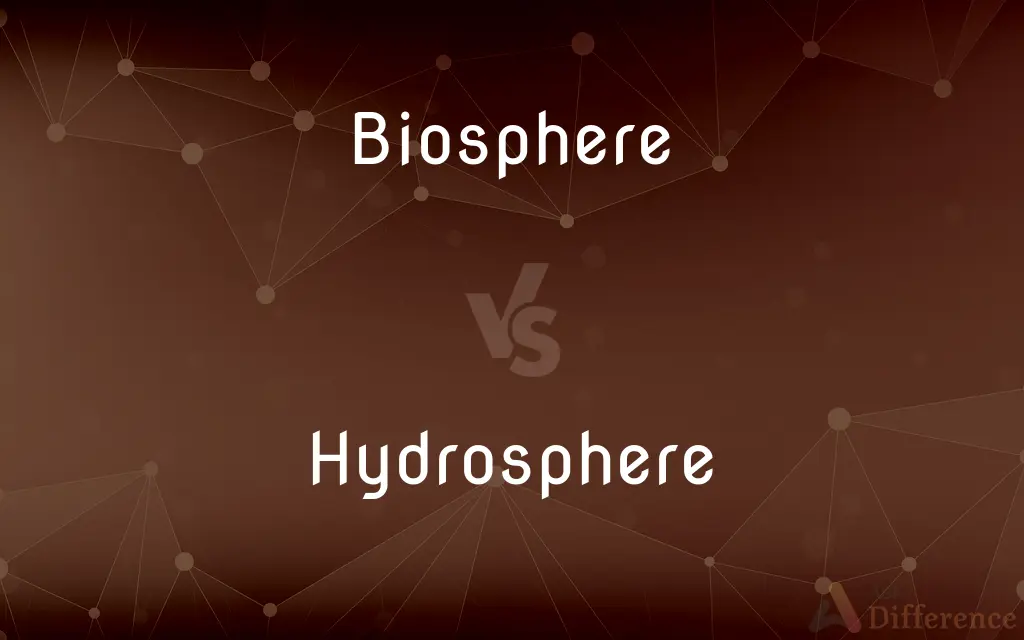Biosphere vs. Hydrosphere — What's the Difference?
Edited by Tayyaba Rehman — By Fiza Rafique — Updated on May 16, 2024
The biosphere encompasses all living organisms on Earth and their interactions with the environment, while the hydrosphere includes all water bodies, such as oceans, rivers, and lakes, on the planet.

Difference Between Biosphere and Hydrosphere
Table of Contents
ADVERTISEMENT
Key Differences
The biosphere consists of all ecosystems and living organisms on Earth, including plants, animals, fungi, and microorganisms. It extends from the deepest root systems in the soil to the upper reaches of the atmosphere where life exists. The hydrosphere, on the other hand, includes all forms of water on Earth, such as oceans, rivers, lakes, glaciers, and groundwater. It plays a vital role in regulating the planet's climate, supporting life, and shaping geographical features.
While the biosphere is focused on life and biological processes, the hydrosphere is concerned with water in all its forms and the physical and chemical processes involving water. Both spheres are interconnected; the biosphere depends on the hydrosphere for water, a critical resource for all living organisms, and the hydrosphere supports the biosphere by providing habitats and influencing climate patterns.
The biosphere relies on the hydrosphere for essential processes like photosynthesis and nutrient cycling, whereas the hydrosphere benefits from the biosphere through the regulation of water quality and storage by vegetation and soil organisms. These interactions illustrate the complex interdependence between living organisms and water bodies.
Understanding both spheres is essential for studying ecological balance, environmental sustainability, and the impacts of human activities on Earth's natural systems. The biosphere and hydrosphere collectively contribute to the overall functioning and health of the planet.
Comparison Chart
Definition
All living organisms and ecosystems on Earth
All water bodies on Earth
ADVERTISEMENT
Composition
Plants, animals, fungi, microorganisms
Oceans, rivers, lakes, glaciers, groundwater
Focus
Biological processes and life forms
Water in all its forms and water cycles
Interaction
Interacts with atmosphere, lithosphere, hydrosphere
Interacts with atmosphere, lithosphere, biosphere
Importance
Sustains life and biodiversity
Regulates climate, supports life, shapes geography
Examples
Forests, coral reefs, deserts
Oceans, rivers, glaciers
Compare with Definitions
Biosphere
Encompasses all living entities and their interactions with the environment.
Human activities impact the biosphere by altering habitats.
Hydrosphere
The combined mass of water found on, under, and over the surface of a planet.
Groundwater reserves are a crucial component of the hydrosphere.
Biosphere
The regions of the surface, atmosphere, and hydrosphere of the Earth occupied by living organisms.
Microorganisms in the soil contribute to the biosphere's diversity.
Hydrosphere
The aqueous envelope of the Earth, including water vapor in the atmosphere.
The hydrosphere is essential for the water cycle, supporting life on Earth.
Biosphere
The zone of life on Earth, integrating all living beings and their relationships.
Coral reefs in the ocean are a crucial component of the biosphere.
Hydrosphere
All water, in any form, present on the Earth’s surface.
Glaciers and ice caps are important parts of the hydrosphere.
Biosphere
The global sum of all ecosystems and living organisms.
The Amazon rainforest is a vital part of the biosphere.
Hydrosphere
All the waters on the Earth's surface, including oceans, lakes, rivers, and glaciers.
The Pacific Ocean is a major part of the Earth's hydrosphere.
Biosphere
The sphere where biological activity occurs.
The biosphere includes ecosystems such as grasslands and wetlands.
Hydrosphere
The total amount of water on a planet.
Rivers and lakes contribute to the hydrosphere's freshwater supply.
Biosphere
The biosphere (from Greek βίος bíos "life" and σφαῖρα sphaira "sphere"), also known as the ecosphere (from Greek οἶκος oîkos "environment" and σφαῖρα), is the worldwide sum of all ecosystems. It can also be termed the zone of life on Earth.
Hydrosphere
The hydrosphere (from Greek ὕδωρ hydōr, "water" and σφαῖρα sphaira, "sphere") is the combined mass of water found on, under, and above the surface of a planet, minor planet, or natural satellite. Although Earth's hydrosphere has been around for about 4 billion years, it continues to change in shape.
Biosphere
The part of the earth and its atmosphere in which living organisms exist or that is capable of supporting life.
Hydrosphere
The waters of the earth's surface as distinguished from those of the lithosphere and the atmosphere.
Biosphere
The living organisms and their environment composing the biosphere.
Hydrosphere
The water vapor in the earth's atmosphere.
Biosphere
The part of the Earth and its atmosphere capable of supporting life.
Hydrosphere
All the liquid waters of the Earth, as distinguished from the land and the gases of the atmosphere.
Biosphere
The totality of living organisms and their environment.
Hydrosphere
The aqueous vapor of the entire atmosphere.
Biosphere
The regions of the surface and atmosphere of the Earth (or other planet) where living organisms exist
Hydrosphere
The aqueous envelope of the earth, including the ocean, all lakes, streams, and underground waters, and the aqueous vapor in the atmosphere.
Hydrosphere
The watery layer of the earth's surface; includes water vapor
Common Curiosities
How do the biosphere and hydrosphere interact?
They interact through processes like the water cycle, nutrient cycling, and habitat provision, supporting life.
Can life exist outside the biosphere?
Life as we know it is confined to the biosphere, where conditions are suitable for living organisms.
What is the biosphere?
The biosphere encompasses all living organisms and their interactions with the environment on Earth.
What is the hydrosphere?
The hydrosphere includes all water bodies on Earth, such as oceans, rivers, lakes, and glaciers.
How does the biosphere affect the hydrosphere?
The biosphere affects the hydrosphere through processes like water filtration by plants and soil organisms, and nutrient release.
How does the hydrosphere affect the biosphere?
The hydrosphere provides essential water resources for life processes in the biosphere and influences climate patterns.
What role do humans play in the hydrosphere?
Humans impact the hydrosphere through activities like water pollution, dam construction, and over-extraction of water resources.
How does climate change affect the biosphere?
Climate change affects the biosphere by altering habitats, affecting species distribution, and impacting ecosystems' health.
What is the significance of the biosphere in environmental sustainability?
The biosphere is crucial for maintaining ecological balance, supporting biodiversity, and providing ecosystem services.
Why is the hydrosphere important?
The hydrosphere regulates the Earth's climate, supports life, and shapes geographical features.
What are some examples of the biosphere?
Examples include forests, deserts, coral reefs, and grasslands.
What are some examples of the hydrosphere?
Examples include the Atlantic Ocean, the Nile River, Lake Superior, and the Antarctic ice sheet.
How does climate change affect the hydrosphere?
Climate change affects the hydrosphere by causing sea level rise, changing precipitation patterns, and increasing the frequency of extreme weather events.
What role do humans play in the biosphere?
Humans impact the biosphere through activities like deforestation, pollution, and urbanization, affecting ecosystems and biodiversity.
What is the significance of the hydrosphere in environmental sustainability?
The hydrosphere is essential for maintaining water resources, supporting aquatic ecosystems, and regulating the Earth's climate.
Share Your Discovery

Previous Comparison
Flushed vs. Pale
Next Comparison
Timesheet vs. RosterAuthor Spotlight
Written by
Fiza RafiqueFiza Rafique is a skilled content writer at AskDifference.com, where she meticulously refines and enhances written pieces. Drawing from her vast editorial expertise, Fiza ensures clarity, accuracy, and precision in every article. Passionate about language, she continually seeks to elevate the quality of content for readers worldwide.
Edited by
Tayyaba RehmanTayyaba Rehman is a distinguished writer, currently serving as a primary contributor to askdifference.com. As a researcher in semantics and etymology, Tayyaba's passion for the complexity of languages and their distinctions has found a perfect home on the platform. Tayyaba delves into the intricacies of language, distinguishing between commonly confused words and phrases, thereby providing clarity for readers worldwide.
















































